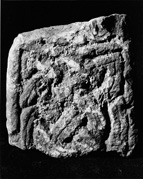Select a site alphabetically from the choices shown in the box below. Alternatively, browse sculptural examples using the Forward/Back buttons.
Chapters for this volume, along with copies of original in-text images, are available here.
Object type: Part of cross-shaft and -head
Measurements: H. 17.5 cm (6.75 in); W. 24.5 > 21 cm (9.5 > 8.25 in); D. 11 > 10 cm (4.25 > 4 in)
Stone type: Medium-grained red sandstone (St Bees sandstone)
Plate numbers in printed volume: 72 - 5
Corpus volume reference: Vol 2 p. 60
(There may be more views or larger images available for this item. Click on the thumbnail image to view.)
Upper part of rectangular shaft with remains of possible circle head. The decoration on all four faces is framed by a roll moulding and on face A the curved top of the shaft panel remains.
A (broad): At the top are traces of interlace ornament on the head. Below the curved border is (probably) a terminal register, a form of half pattern F with outside strand, using median-incised strands.
B (narrow): Zoomorphic head with round eye and cabled top; the long upper jaw remains.
C (broad): A free ring with long diagonals and outside strands, linked to what was probably part of a register of a form of half pattern F with outside strand, using median-incised strands.
D (narrow): Curled (foliate?) terminal of a run of Stafford knots with median-incised strands; the double strand of the interlace is bound near the terminal.
Beckermet school (Introduction, pp. 38–40). This stone draws on several pattern types and ornamental details which are otherwise rare or unknown outside the school. Thus, the interlace on face A links this carving to Beckermet St John 3, 4, and 5 and Workington 4. The latter stone and Haile 2, furthermore, use an identical interlace to that used here on face C, whilst the trick of binding across strands is repeated in the group on Beckermet St John 4 and 7, on Haile 2 and Workington 4. To the details which link this carving to Beckermet St John 4 and Haile 2 we can also add their sharing of the distinctive beast-head terminal seen here on face B; so closely are these three carvings linked that it is difficult to avoid the conclusion that they are work of the same hand.
The curved border on face A suggests that this shaft had a circle-head, type 3. It can, admittedly, be shown that free-armed or ring-headed crosses have curved junctions with the shaft but in those cases the two parts are set in different planes, unlike this Beckermet arrangement.



